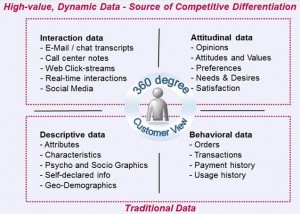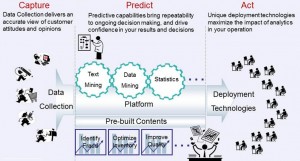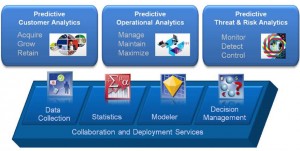Introduction to Predictive Modeling
Predictive Analytics 101
Business intelligence focuses on the identification and understanding of events that happened in the past; that is “what’s happened?” and “why has it happened?” Business imperatives and other constraints are increasingly driving organizations to look forward and use their data to ensure decisions that are being made today will lead to wins in the future. Predictive analytics has often been viewed with hesitation and intimidation and seen as only relevant to statistical specialists, but with the advent and evolution of the IBM SPSS solutions, the power of predictive analytics can be harnessed by a much broader group of users. This newsletter article describes what predictive analytics is, how it is used, when it is used, and how to integrate it into your organization.
What is Predictive Analytics?
Three terms go hand-in-hand when talking about predictive analytics:
- Predictive analytics: the area of data mining focused in forecasting probabilities and trends.
- Data mining: the process that attempts to discover patterns in large data sets and transform those discoveries into an understandable structure for further use.
- Predictive modeling: a process used to create statistical models of future behavior.
Some Applications of Predictive Modeling and Data Mining
Every organization can benefit from predictive modeling and data mining. A few examples include the following:
Analytical Customer Relationship Management (CRM) – Direct Marketing (Database) Marketing
- New customers acquisition
- Customers retention
- LTV (Life Term Value)
- Segmentation & segment imputation
- Revenue optimization using up-sell, cross-sell, uplift, next best offer and contact channel selection models
Risk / Fraud
- Insurance (claims & claims cost)
- Loans and credit risk
- Crime and national security
- QA failures and service
- Health and disease risks
- Audit and investigation targeting
Pharmacological, Genetics and Health Research
- Research of secondary effects in drug development to refine the definition of the target population for the new drug
- Prediction of diseases based on genes, lifestyle and environment and medical history
- Prediction of disease rates and epidemics
Time Series Forecasting
(Models that predict future values based on previously observed values measured at uniform time intervals)
- Sales
- Inventory levels
- Capability demand
- Natural phenomena
- Employees attrition
- Prices
- Other economy related measures
The Most Comprehensive View of Your Organization
The development and integration of powerful hardware and software systems can deliver a true and complete 360 degree view of your organization in virtually “real time” fashion. The usage of predictive analytics will provide invaluable glimpses into the future, assisting your organization in creating both proactive and preventive strategies.
Predictive modeling and data mining methodologies can be applied both to internal organizational data and customer data related to current, former, and potentially future clients.
We can broadly rank data source types by predictive power, from stronger to the weaker as follows:
Behavioral data (consumer behavior): Orders, transactions, payment and usage history, etc.
Interaction data: E-mail/chat transcripts, call center contacts and notes, web click-streams, real-time interactions and social media.
Attitudinal data: Opinions, attitudes and values, preferences, needs & desires, satisfaction.
Descriptive data: Attributes and characteristics (psycho and socio graphics), self-declared information and geo-demographics.
The Integrative Implementation of Predictive Analytics
The seamless integration between IBM SPSS and the IBM BI and data management solutions, such as Cognos and Netezza, deliver the opportunity to capture continuously updating data from a multitude of sources, and analyze that data with one of the richest modeling tool sets in the industry.
IBM SPSS Modeler can read and write directly from and to Cognos data files. It also supports integration with IBM Netezza Analytics, which provides the ability to run advanced analytics on IBM Netezza servers. These features can be accessed through the SPSS Modeler graphical user interface and workflow-oriented development environment, allowing you to run the data mining algorithms directly in the IBM Netezza environment. With Netezza Analytics you can run powerful predictive and data mining algorithms, such as Decision Trees, K-Means, Bayes Net, Naive Bayes, KNN, Divisive Clustering, PCA, Regression Tree and Linear Regression. The IBM SPSS Modeler also can be integrated similarly with IBM InfoSphere Warehouse, Microsoft Analysis Services and Oracle Data Mining.
Using the IBM SPSS and the other IBM technologies, the knowledge created by this process can be continuously deployed at every delivery point in the organization where it improves your decision making, supports strategies and tactics, planning and technology improvements, etc.
The IBM SPSS Toolset
IBM SPSS products cover the whole predictive Modeling cycle and are organized into four families:
- Data Collection: with a feature-rich suite of survey research software, IBM SPSS Data Collection provides a detailed view of customer attitudes and opinions
- Statistics: IBM SPSS Statistics and its modules that include basic to the most advanced and sophisticated procedures.
- Modeling: IBM SPSS Modeler Professional for data mining and IBM SPSS Modeler Premium, which adds the most advanced text analytics capabilities.
- Deployment: providing the platform and the delivery products that bridge analysis and action. They include IBM SPSS Collaboration and Deployment Services and IBM SPSS Decision Management.
The Optimal Portfolio of Services and Products
Ironside has over a decade of experience working with IBM and a team of predictive analytics consultants with more than 30 years of cumulative experience. We offer modular and scalable solutions adapted to your needs, size and complexity, from SOHO and small business to multinational organizations and from consulting and training to full turnkey systems.





